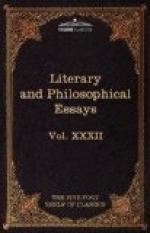It remains to be said that, even in our own days, the powerful originality of Celtic Christianity is far from being effaced. The Bretons of France, although they have felt the consequences of the revolutions undergone by Catholicism on the Continent, are, at the present hour, one of the populations in which religious feeling has retained most independence. The new devotions find no favour with it; the people are faithful to the old beliefs and the old saints; the psalms of religion have for them an ineffable harmony. In the same way, Ireland keeps, in her more remote districts, quite unique forms of worship from those of the rest of the world, to which nothing in other parts of Christendom can be compared. The influence of modern Catholicism, elsewhere so destructive of national usages, has had here a wholly contrary effect, the clergy having found it incumbent on them to seek a vantage ground against Protestantism, in attachment to local practices and the customs of the past.
It is the picture of these Christian institutions, quite distinct from those of the remainder of the West, of this sometimes strange worship, of these legends of the saints marked with so distinct a seal of nationality, that lends an interest to the ecclesiastical antiquities of Ireland, of Wales, and of Armorican Brittany. No hagiology has remained more exclusively natural than that of the Celtic peoples; until the twelfth century those peoples admitted very few alien saints into their martyrology. None, too, includes so many naturalistic elements. Celtic Paganism offered so little resistance to the new religion,




